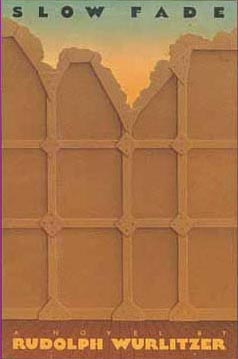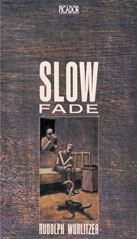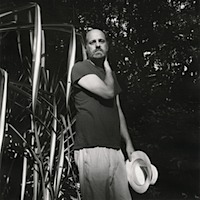This book review appeared in the December 14, 1984 issue of the Los Angeles Reader. For more on Wurlitzer, readers are invited to check out my reviews of Walker and Candy Mountain in the Chicago Reader, both available on this site, as well as a more comprehensive piece about his work as a novelist and screenwriter, published in Written By. — J.R.
Slow Fade
By Rudolph Wurlitzer
Alfred A. Knopf: $13.95
By Jonathan Rosenbaum
The difference between the art novel and the Hollywood novel can be as vast as the reaches between the East coast and the West coast, and any effort to wed the two in a shotgun marriage is liable to blow up in one’s face. Slow Fade, while an exceptionally and deceptively easy read, is far from being an easy book — which is one of the best things about it. That’s probably what Michael Herr means by “dangerous” in his jacket-blurb patter: “Slow Fade comes out of the space between real life and the movies and closes it up for good. A great book: beautiful, funny, and dangerous.” Any novel that begins with one character losing an eye and ends up with another losing his index finger is bound to be fraught with scary Oedipal tensions, and Slow Fade goes out of its way to make the most out of them.
Despite certain stylistic continuities in Wurlitzer’s four slim novels to date, which link them all spiritually to Wim Wenders’ road movies and Sam Shepard’s theatrical Marlboro commercials — short laconic sentences, modernist neocowboy sentiments — they are radically different ventures and experiences. Nog (1969), the hardest to describe and probably the most enduring, survives as one of the key stoned novels of the sixties; as Richard Poirier points out in The Performing Self, it offers a stylistic approximation of the loss of identity found in many of the more nonverbal extremities of drug culture during that period. Flats (1970), the artiest, offers a Beckett-inspired conundrum featuring macho tramps (named after American cities) who do very little. Quake (1972), the plainest (as well as the most pretentiously unpretentious), gives us a postapocalyptic Los Angeles in the pulpy manner of Panic in Year Zero (a crumblimg Tropicana Motel; Melrose declaring war against Wilshire).
Slow Fade, the first Wurlitzer novel to appear in a dozen years, is the funniest, the longest (at 211 pages), and the least cryptic; it is also the most mainstream in scale and intention. While Quake certainly aimed at some of the spectacle and action of the exploitation film, Slow Fade aims higher and tries for some of the exploitation values of spectacle and action to be found in the art film, from Coppola to Cimino. Dealing directly with movies and moviemaking and indirectly with the fate of sixties mysticism, it needs to be seen at least partially within the context of the exploitation/art films on which Wurlitzer has worked as a scriptwriter: among others, Monte Hellman’s Two-Lane Blacktop and Jim McBride’s Glen and Randa (both 1971), Sam Peckinpah’s Pat Garrett and Billy the Kid (1973), and Robert Frank’s Energy and How to Get It (1981). No less relevant is a recent art film on which Wurlitzer had no creative role, but which almost certainly fed many of the ideas explored and exploited here: Wim Wenders’ disturbing account of Nicholas Ray’s last days in Lightning Over Water (1980).
More journalistic than Wurlitzer’s earlier books, this new novel offers a wealthy tourist’s glimpse of India, Mexico, and Newfoundland, as well as stateside filmmaking and gambling; it surveys a particular state of mind and income bracket that usually go together. At the outset we meet A.D. Ballou, an anything-goes hustler who flies to Santa Fe from New York to work as road manager for a group called the Gang Greene, only to find the group in total dissolution upon arrival. Straying onto a location where old-time Western director Wesley Hardin is filming an Indian ambush, he loses his left eye to an arrow and soon afterward finds himself in a script development deal bankrolled by Hardin, in collaboration with Hardin’s son Walker. About three years earlier, Hardin’s daughter Clementine went to India on a religious quest and was never heard from again; Hardin eventually sent Walker with his newlywed wife off to India in search of Clementine, and Walker has just returned, burned out, without wife, sister, or explanation. Hardin schemes to induce A.D. to convince Walker to turn his Indian adventures into a script that Hardin will eventually film.
***
As improbable as this setup sounds, Wurlitzer gets away with it by making Hardin an outsized Old Hollywood legend who could conceivably concoct such a scheme and uses this notion to propel his own basic storytelling structure. The story alternates between Hardin in Santa Fe, Mexico, and New York — shooting a last-stand Western until the producer blows the whistle and shuts off the funds, generating a cinéma vérité chronicle of his own life — and A.D. and Walker writing their script on the road, so that each movement in the present is complemented by an additional piece of the past uncovered. Apart from generating a respectable amount of plot suspense, this narrative counterpoint allows Wurlitzer to pursue a satirical bent as he charts both fantasy trips, which becomes a contrast between the spiritual excesses of two generations: Yoesmite Sam and Mr. Natural, each on a suicide mission. The vast expenditure of money in both plots becomes part of the overall point. Hardin and his entourage are on a demented spiritual quest while trying to shoot their movie, at the same time that Walker and A.D.’s script-in-progress depicts a pathetic, movie-inspired look at the American abroad in search of salvation. Imagine John Ford and Salinger’s Franny Glass trying to negotiate a contract and you get some notion of the manifold contradictions Wurlitzer straddles.
Two matching farcical high points: Wesley freaking out in Durango, Mexico, while shooting his Western; a Terry Southern-ish episode on a train in India (in A.D. and Walker’s script) when an American hippie couple ecstatically hornswoggle the fictional counterparts of Walker and his wife out of most of their belongings. The former scene, more Western (as in Nathanael) than Southern, proceeds through a sort of deadpan prose that seems almost obligatory to this sort of extravaganza:
The saloon was half complete, being in the middle of a transformation of a Mexico City whorehouse to a border town cantina with crude wooden tables, low smoke-blackened ceiling, and a bar where several jars held live tarantulas and the curled form of a diamondback rattlesnake. Wesley took a table at the far end, facing the swinging doors. Pouring half the pharmaceutical coke on the table, he fashioned six rough lines, snorting them up with a rolled peso note and handing the note to his wife Evelyn.
“You are my life,” he whispered, kissing her on the ear.
“Is that why you are trying to end it?”
“Not end, precisely, to come to terms with, to slowly dissolve, perhaps.”
“Why not just cut to black,” she said, inhaling the rest of the coke.
“Why not, indeed.”
***
By the time Wurlitzer shifts the entire action, cast, and crew up to Newfoundland, both putative movies have merged into one — a single apocalyptic Walpurgis Night reeking of death and hysteria. Ending finally in a situation and setting sketched out as grimly yet comfortably postfilmic, the prose seems to breathe a sign of relief before expiring with a slow fade into one more macho myth of the mind. Like his deranged hero, Wurlitzer goes out in style and solemnly crawls his way back to Hemingway.
—Los Angeles Reader, December 14, 1984 (slightly revised, December 2009)





